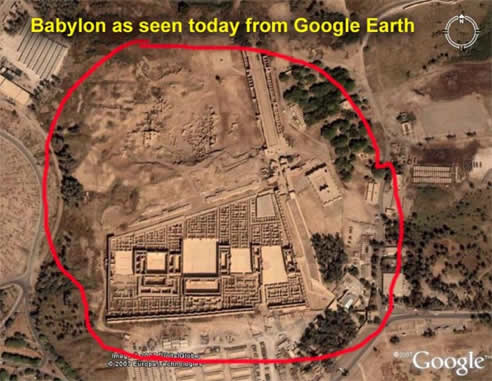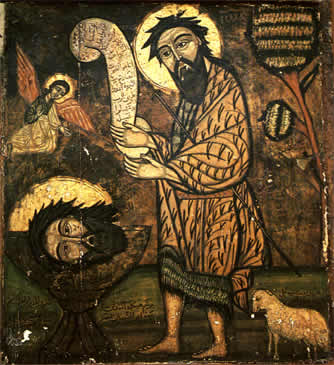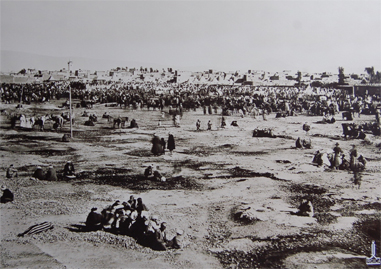|

|

DAMASCUS IN HISTORY AND PICTURES...
http://historic-cities.huji.ac.il/syria/damascus/maps/olfert_dapper_1677_damascus_b.jpg
Examples of "The Amarna Letters", an important cache of documents discovered in 1887 by a village woman digging for fertilizer. There are 382 known clay cuneiform tablets, whose contents shed light on Egyptian relations with Babylonia, Assyria, the Mitanni, the Hittites, Syria, Palestine and Cyprus. They are important for establishing both the history and chronology of the period. www.egyptologyonline.com/a_unified_chronology.htm
Damascus is located ca. 50 miles from the Mediterranean Sea, ca. 2,200 ft above the sea-level. The Old Damascus delineated by the city walls is on the south bank of the river Barada.
Barada today is almost dry (ca. 3 cm of water is left) due to several droughts in the last decades but in the past it supported ever-growing population of the area.
Barada is disappearing in front of our eyes. In 2006 film, "Before Vanishing," Joude Gorani documented how this once spectacular river "has suffered from exploitation, neglect, pollution and unplanned urbanization." http://www.sfeir-semler.com/current/InTheMiddle/Middle.htm
The Old City of Damascus may soon join Barada in her vanishing act. In spite of numerous protests the Syrian government continues its modernization plans destroying the Old Damascus in the process. These plans have been put on hold more than once as the UNESCO threatened to withdraw Damascus' World Heritage status.
The Old Damascus city is surrounded by walls. There are seven gates leading to the city of which the oldest preserved one is of the Roman origin (Bab al Faradis [Paradise]).
www.flickr.com/photos/ abetshlimon/377076964/ Bab Tuma (Thomas Gate). The northern gate named after a famous Roman leader.
Population: ca. 4,000,000 (total population of Syria -- 19,747,586). 90% of the Syrian population -- Arabs. The largest non-Arab minorities are Kurds and Armenians. Damascus claims to be the oldest continuously inhabited city in the world since the Neolithic settlement of the ca. between 10,000 and 8,000 B.C., Tell Ramad, was found within the city limits (actually 15 km south-west). The other city competing for this title is Jericho in Israel (starting with the 9th millennium B.C. as a small settlement and walled in the 7th millennium B.C.)
The 2nd millennium B.C.
Aram Damascus -- an Aramaean city-state founded ca. 1100 B.C. The 1st millennium B.C. was characterized by conflicts with the Assyrians and Israelites. The remains of the city of this time period are probably under the eastern part of the old city. Captured and destroyed by Tiglatpilessar III in 732 B.C. (see above) 
Damascus was ruled by Babylonians between 572 (Nebuchadnezzar) and 538 B.C.
Damascus became the capital of the Persian province of Syria after Cyrus the Great conquered the city in 538 B.C.
Alexander the Great finished the Persian domination but ... soon after (323 B.C.) he died. Damascus and Syria in general became the point of contention between the Seleucid and Ptolemaic rulers. This too was put to the end in 64 B.C. when the Romans took over Damascus as a part of western Syria.

John the Baptist who died ca. 30 is believed to have his head enshrined in the Umayyad Mosque. Below: Shrine of St. John the Baptist, said to contain his head. Pope John Paul II came to see the shrine in 2001, the first pope to visit this mosque.
However, there are plenty other claimants to keeping St. John's head (plus another bunch of those who claim other body parts as relics). Here are the famous ones:
The most glorious times Damascus have experienced under the Islamic control of the city. Conquered in 634 by the Rashidun Caliphate, she became the capital of the Ummayad empire (661-750). Picture: courtesy of Safwan Oaity.
The Umayyad Mosque hosts yet another important relic: the head of Hussein ibn Ali (626-680), a grandson of Prophet Muhammad, son of Imam Ali and Fatimah, daughter of the Prophet. He is one of the infallible Shia Imams. The rest of his body is buried in Kerbala, Iraq. He refused to pledge his loyalty to the Umayyads, challenged their rule and, as the result, was killed and beheaded in the Battle of Kerbala. ASHURA -- a day or mourning observed especially by the Shia Muslims every year is the anniversary of his martyrdom (see below). His death mobilized his followers, led to the weakening of the Umayyads and strengthening of the Shia movement.
http://timemiddleeast.files.wordpress.com/2008/11/Ashura%20Haidar%20Circle.jpg
Kerbala (Iraq). Imam Hussein's Shrine.
The Umayyad Mosque's ablution fountain is said to mark the halfway point between Istanbul and Mecca.
Women's section in the Umayyad Mosque
The Seljuk Turks set up Damascus as an independent city once again. Though their rule lasted only for 25 years, another group of Turks, the Burid Emirs, took care of the city defending her from the Crusades in 1148 (the Second Crusade).
http://www.uncp.edu/home/rwb/Crusades_Map.gif
The famous citadel of Damascus is situated in north-western corner of the Old Damascus between Bab al Faraj and Bab al-Nasr (the current entrance to the famous Souk al-Hamidiya.
The citadel is quite unusual because it is built on the same level as the city. To make up for the lack of natural elevation its architects had to focus on the huge size of the fortification walls and heights of the towers.
The appearance of the citadel (castle) is somewhat misleading due to its visible Roman or Byzantine features. The Roman stones clearly recognized as a part of the castle are actually re-used.
In 1202 the Seljuk castle was demolished so a new one could be built. King Al-Adel was afraid that the old construction was outdated and consequently would not withstand the expected Crusaders' attack. Courtesy of Safwan Oaity.
Saladin (the "Righteousness of Faith," Yusuf ibn Ayyub Saladin) (1138-1193), who is among the most celebrated heroes of the Middle East, was neither an Arab nor a Turk, not even a Persian. Saladin was Kurdish. His ties with Damascus were strong since he studied there. Thus, it is nor surprising that once in charge of this great city he rebuilt the citadel, expanded the city and turned it into an intellectual hub for anyone who sought knowledge.
The Damascene (Damascus) steel is hot-forged steel of which legendary Damascus swords were made. It was believed that such was their quality and sharpness that these swords could easily cut through not only much lesser quality European weapons but even through rock. While we are still not sure about techniques used to produce the Damascus steel, we know that the metal had a visible, often textured, grain pattern. Modern patterned steel is still called "damascened." Original photographs of the famous Sword makers of Damascus taken by Underwood and Underwod photographer in 1900 in Damascus, Syria. Numbered at the bottom. These photos were later used in the production of Underwood's stereoviews. http://mideastimage.com
Saladin, whose victories and finally capturing Jerusalem in 1187 from the Crusaders, was vastly admired not only by his Muslim brothers but by the Europeans as well. To regain the lost territory of the European Christendom in the Middle East the special tax, "Saladin Tithe" was imposed in 1188 in England and some parts of France. Richard the Lionheart (king Richard I of England; above) led the Third Crusade whose success was somewhat limited but resulted in the peace treaty at Ramla in 1192.
Richard the Lionheart recovered from his fever and left the Middle East just about the time when Saladin himself acquired one and died of it on March 1193 in Damascus. Famous for his charities, Saladin died as a very poor man, not leaving even enough money for his own funeral. Regardless, his loyal subjects built him a great mausoleum just outside of the Ummayad Mosque. He was put to rest in a wooden coffin where he stays undisturbed until today. Next to the wooden coffin is a fabulous marble sarcophagus sent to Damascus by Wilhelm II of Germany (19th-20th century) to provide a much more fitting coffin for the famous hero. However, nobody every dared to interrupt Saladin's eternal sleep.
Kaiser Wilhelm II toured the Ottoman provinces of the holly land and Syria. His visit was photographically documented by the Armenian photographer Garabed Krikorian (1847-1920). During his visit to Damascus he laid a Bronze wreath over the tomb of Saladin. It was later removed on the entry of the Arab and British forces to Damascus in 1918. The Emperor's tour was highly publicized by Germany to cement the alliance between Germany and the Ottoman Empire which culminated in the alliance of Germany, the Austro/Hungarian Empire and the Ottoman Empire during WWI with catastrophic outcome to all three Empires and the permanent loss of the Arab provinces of the Ottoman Empire to France and England. http://mideastimage.com
The oldest maps of Damascus: 1575, Braun and Hogenberg, Civitates Orbis Terrarum. http://historic-cities.huji.ac.il/syria/damascus/maps/olfert_dapper_1677_damascus.html
The Ottoman Turks took great care of Damascus for the next 400 years. Although she was not the most important city in Syria at the time (Aleppo was), the Ottoman Sultans made sure that Damascus would represent well their devotion to Islam by turning her into a very important point of Haji pilgrimages to Mecca. Courtesy of Safwan Oaity. 
The "only" black spot on otherwise relatively positive rule of the Ottomans in Damascus was the infamous massacre of the Christians in 1860. However, it must be remembered that this conflict between the Druze and the Maronites was instigated and fueled by foreign powers (France, England) which wanted to weaken the Ottoman Empire at any cost. The sultans tried to prevent it through different means including even division of Lebanon into the Druze and Christian ruled territories. Unfortunately, this division was eventually blamed by the European powers as responsible for the escalation of the conflict which led to ca. 10,000 Christians dead (mostly Maronites but also Greek Orthodox and Catholics). The Christian quarter in the Old Damascus was completely burnt down. The only Christians who survived this massacre were the poorest ones living outside of the city, in the district known as Midan. They were protected by their Muslim neighbors. Courtesy of Safwan Oaity.
Glass-photo, ca 1860, of the destruction of the Christian Quarter in Damascus in 1860. http://mideastimage.com The violent incident started on the 9th of July, when a mob of 20,000-50,000 from the Maidan, and Salihya districts of Damascus attacked, killed and pillaged the Christian Quarter and its inhabitants, 5,000 to 12,000 were estimated to have perished. The Greek Orthodox, the Greek Catholic and the Armenian churches were the first to be burned. The Russian consulate was the first to be attacked, followed by the French, then the Dutch, Austrian, Belgian and the American consulates. Abdu Costi, the American Consul was beaten and left for dead. The Prussian and the English Consulates were saved. "AN OCCASION FOR WAR, Leila Tarazi Fawaz, University of California Press, 1994". Abdul Qadir al-Jazairi, the exiled Algerian hero, along with his 1000 volunteers protected most of the Diplomats, and thousands of Christians in his houses. He was awarded the highest medals by the European governments. The building on the left is the French Lazarists Monastery and school burned by the attackers.
This unfortunate event opened the door for France and Britain's interventions in the region, especially in Lebanon. With the Ottoman power losing its grip on their numerous possessions in the Middle East, Europe and elsewhere, the Europeans were more than happy to support any nationalistic movements against the Turkish Ottomans. Courtesy of Safwan Oaity.
The French and the British made numerous promises to the Arabs regarding creation of the independent Arab nation(s) in Greater Syria. Whether they intended to keep these promises in any form or shape is a subject of contention among modern scholars. The fact is that on May 16, 1916, the so-called Sykes-Picot(-Sazonow) Agreement was signed between the British and the French with the Russian (still as the Empire) blessing. This was a secret agreement which "divided" the Middle East into European spheres of influence after the expected fall of the Ottoman Empire. Courtesy of Safwan Oaity.
http://www.passia.org Although this agreement technically dealt only with the trade and political influence in the areas to be ruled mostly by the Arabs, once it was revealed by the Bolsheviks in "Izviestia" and "Pravda" newspapers on November 23, 1917, the Arabs started to distrust their European allies. Even the Zionists were not happy since the British promised them (sort of) an independent state of Israel (the Balfour Declaration of 1917) with other non-Jewish communities having rights too.
However, the Arabs didn't have much choice: either they were to support the falling Turkish-Ottoman Empire or hope for the best from Europe. The Arabs entered Damascus as victors (Arab Revolt) in October 1918. http://mideastimage.com October 1, 1918. "Rushing forward on horseback, the 10th. Light Horsemen seemed engulfed by the dust and the terrible noise. But as they advanced, the possibility increased that they would soon , within less than half an hour , be the first European force to take Damascus for over thousand years. Lawrence had written : " Damascus is a lodestar to which Arabs are naturally drawn, and a city that will not easily be convinced that it is subject to any alien race". And so it proved to be. The Australians rode quickly out beyond the city and on the road to Aleppo". FIRST TO DAMASCUS JILL, DUTCHESS OF HAMILTON, KANGAROO PRESS.
Soon they adopted a democratic constitution and proclaimed King Faisal as a king of Syria (with the approval of Mecca; Faisal was a son of Sharif Hussein of Mecca). The French were not too happy about this new independent state and after the Versailles Conference (Paris Peace Conference 1919) which granted France a mandate over Syria (see the flag below), French army entered Damascus in 1920.
King Faisal bin Al Hussein bin Ali El-Hashemi was a member of the Hashemite dynasty and a descendant of Prophet Muhammad ('peace be upon him"). He was a man of many talents whose dedication to establishment of independent Arab states is not to be questioned. He supported the Great Britain in the WWI; was a friend of Lawrence of Arabia with whom he fought for Arab independence from Turks; and he secured Gertrude Bell's assistance when arguing for independent Arab states during the peace conference in Paris in 1919. He was not opposed to Arab-Jewish cooperation and actually "wish the Jews a most hearty welcome home…" His rule over Greater Syria lasted only for a couple of months in 1920. Once expelled from Syria he left for Great Britain. The British government who held the mandate over Iraq proclaimed him a king of Iraq in August 1921 to avoid an inevitable unrest in Mesopotamia. He died on September 8, 1933, of heart attack in Switzerland. Damascus became the capital of the French Mandate. The French kept restructuring their mandate continuously though it was based on 6 original states: Damascus (1920), Aleppo (1920), Alawites (1920), Jabal Druze (1921), Sanjak of Alexandretta (Hatay; 1921), the State of Greater Lebanon (modern Lebanon; 1920).
The oldest maps of Damascus: 1929, Bureau Topographique des Troupes Françaises du Levant. http://historic-cities.huji.ac.il/syria/damascus/maps/tfl_1929_damascus_b.jpg
The French fully intended to keep their Syrian territory and at any signs of trouble they simply bombed the city. This took place in 1925 with the Druze revolt spreading from Hauran; in 1941 when fighting against the Allies, and finally in 1945 when they had to give up Damascus upon the intervention of the British forces. Above: Syrian Druze leaders. http://mideastimage.com
To stop a rising popular rebellion against the French occupation in 1925, the French bombed the Syrian Capital killing an estimated 5,000. http://mideastimage.com
Once the French were gone, Syria established her independence in 1946. Damascus remained her capital and has been thriving toward rebirth of her glorious days again. http://mideastimage.com And finally, just to give you a feeling what it means to stroll through Damascus...
This is my good friend Bassam who drove me around Damascus. Our trips included many good restaurants there. Designed and maintained by Dr. Ewa Wasilewska. January 2010. All rights reserved by Dr. Ewa Wasilewska. Salt Lake City. 2010. |
Let's go to:
|